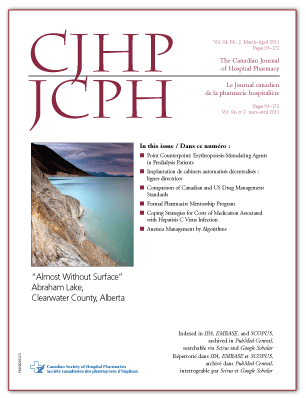Utilisation de lignes directrices dans le cadre de l’implantation de cabinets automatisés décentralisés en établissement de santé
DOI:
https://doi.org/10.4212/cjhp.v64i2.993Keywords:
automation, risk management, quality management, automatisation, gestion des risques, gestion de la qualitéAbstract
ABSTRACT
Context: Few data are available on the use and consequences of decentralized automated dispensing cabinets (ADCs) in institutional settings.
Method: This descriptive study examined compliance with published guidelines on the implementation of decentralized ADCs. The primary objective was to evaluate overall compliance, as well as compliance with specific steps in the medication cycle. The study was carried out at the Centre hospitalier universitaire (CHU) Sainte-Justine, a 500-bed mother-and-child hospital. The 2008 guidelines of the Institute for Safe Medication Practices (US) concerning the safe use of decentralized ADCs and the associated self-assessment tool (2009) were used to evaluate compliance at 30 days and at 120 days after implementation.
Results: From November 2009 to April 2010, 7 decentralized ADCs were brought into service at the CHU Sainte-Justine. Overall compliance with published guidelines increased from 66% to 74% between January and April 2010. For each process related to the safe use of the ADCs, the criteria were briefly described, along with the non-compliance components related to technological or organizational aspects of implementation. For each component for which practice was noncompliant with guidelines, the actions required to modify the equipment (i.e., technological aspects) were determined and conveyed to the manufacturer; similarly, modes of use requiring modification (i.e., organizational aspects) were determined and conveyed to the institution.
Conclusion: This study has described the compliance of practices at the CHU Sainte-Justine with published guidelines of the Institute for Safe Medication Practices. The use of published guidelines can help to guide both the technological and organizational aspects of implementing decentralized ADCs.
RÉSUMÉ
Contexte : Il existe peu de données sur les conséquences de l’utilisation des cabinets automatisés décentralisés (CAD) en établissements de santé.
Méthode : Il s'agit d'une étude descriptive de la conformité des pratiques par rapport à des lignes directrices publiées dans le cadre de l'implantation de CAD. L'objectif principal de l'étude est d'évaluer la conformité globale et celle de chaque processus du circuit du médicament. L'étude se déroule au sein du Centre hospitalier universitaire (CHU) Sainte-Justine, un établissement mère-enfant de 500 lits. À partir des lignes directrices portant sur l'utilisation sécuritaire des CAD de l'Institute for Safe Medication Practice (aux États-Unis) (2008) et de son outil d'autoévaluation (2009), nous avons évalué la conformité de la pratique à 30 jours et à 120 jours après l'implantation.
Résultats : Nous avons procédé de novembre 2009 à avril 2010 à l'implantation de sept stations de CAD au sein du CHU Sainte-Justine. Le profil de conformité est passé de 66 % à 74 % de janvier à avril 2010. Pour chaque processus relatif à l'utilisation sécuritaire des CAD, nous présentons une brève description des critères ainsi que les éléments de non-conformité liés à la technologie ou aux aspects organisationnels. Pour chaque élément de non-conformité, nous avons déterminé les actions requises auprès du fabricant afin de modifier l'équipement (c. à .d. aspects technologiques) et auprès de l'établissement afin de modifier les modalités d'utilisation (aspects organisationnels) en précisant le ou les processus impliqués.
Conclusion : Cette étude décrit la conformité des pratiques au CHU Sainte-Justine par rapport à des lignes directrices publiées par l'Institute for Safe Medication Practices. L'utilisation de lignes directrices dans le cadre de l'implantation de cabinets automatisés décentralisés en établissement peut aider à guider les actions tant sur le plan technologique qu'organisationnel.
Downloads
Downloads
Issue
Section
License
Copyright © Canadian Society of Healthcare-Systems Pharmacy.
After publication of a manuscript in the CJHP, the authors of the manuscript must obtain written permission from the CSHP (publications@cshp.ca) before reproducing any text, figures, tables, or illustrations from the work in future works of their own. If a submitted manuscript is declined for publication in the CJHP, all said rights shall revert to the authors. Please note that any forms (e.g., preprinted orders and patient intake forms) used by a specific hospital or other health care facility and included as illustrative material with a manuscript are exempt from this copyright transfer. The CJHP will require a letter from the hospital or health care facility granting permission to publish the document(s).










